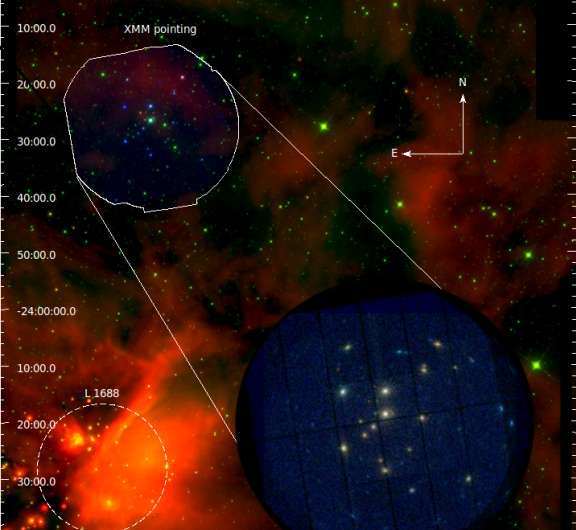May 26, 2016 report
New stars discovered in the Rho Ophiuchi Dark Cloud

An international team of astronomers led by Ignazio Pillitteri of the Palermo Astronomical Observatory in Italy has announced the discovery of 22 new young stellar objects in a star-forming region called the Rho Ophiuchi Dark Cloud. The newly detected stars constitute a small cluster formed about five to 10 million years ago. The findings are presented in a research paper published online on May 24 on arXiv.org.
Rho Ophiuchi Dark Cloud is a dark nebula of gas and dust located some 460 light years away in the constellation of Ophiuchus, making it one of the closest stellar nurseries to our planet. This dense nest of stellar objects is a perfect target for astronomers to search for newborn baby stars.
Recently, Pillitteri and his colleagues decided to conduct a detailed X-ray study of this cloud to track down possible newly born stars. They have analyzed the data provided by ESA's XMM-Newton space observatory, which observed the multiple star system Rho Ophiuchi and its surroundings in August 2013. The spacecraft is able to conduct narrow- and broad-range spectroscopy and to perform simultaneous imaging of objects in both X-ray and optical wavelengths, enabling detailed studies of star-forming regions.
Three European photon imaging cameras (EPIC) mounted on XMM-Newton allowed the scientists to detect dozens of X-ray sources, 22 of which turned out to be diskless class III young stars.
"We detected 89 X-ray sources (…) Based on infrared and X-ray properties, we can distinguish between young stellar objects belonging to the cloud and background objects. Among the cloud members, we detect three debris disk objects and 22 diskless class III young stars," the researchers wrote in the paper.
According to the study, these stars belong to a small cluster born about five to 10 million years ago during a previous event of star formation just north of a dense core of the cloud, designated L1688. This core itself is believed to contain a stellar population of about 300 young stellar objects. The age of the cluster could be confirmed by the near absence of stars with disks.
The scientists try to explain this absence: "We speculate that the densest part cloud was larger in the past and that a fraction of the stars have since migrated away from the cloud. What we observe now is the patchy 'left-over' cloud of a process of star formation that did not occur uniformly across the cloud," the paper reads.
The astronomers noted that a proper indication of the age of the stellar objects in Rho Ophiuchi Dark Cloud along with assessment of the ratio of stars without disks to stars still bearing a disk could be crucial to our understanding of star-forming processes in stellar nurseries. They endorse future X-ray observations of multi-core clouds, emphasizing that current motion studies and infrared observations are unsatisfactory for regions distant than 3,000 light years.
"Proper motion studies have insufficient sensitivity, photometric selection is strongly contaminated by field stars, and spectroscopic selection requires an enormous effort to study hundreds or thousands of stars – even when using new multi-fiber facilities. Infrared studies are helpful (when crowding is not extreme), but they are sensitive only to stars with circumstellar material, bright in infrared, but insensitive to objects without disks, i.e., class III pre-main-sequence stars," the scientists wrote.
More information: arxiv.org/pdf/1605.07365.pdf
© 2016 Phys.org





















